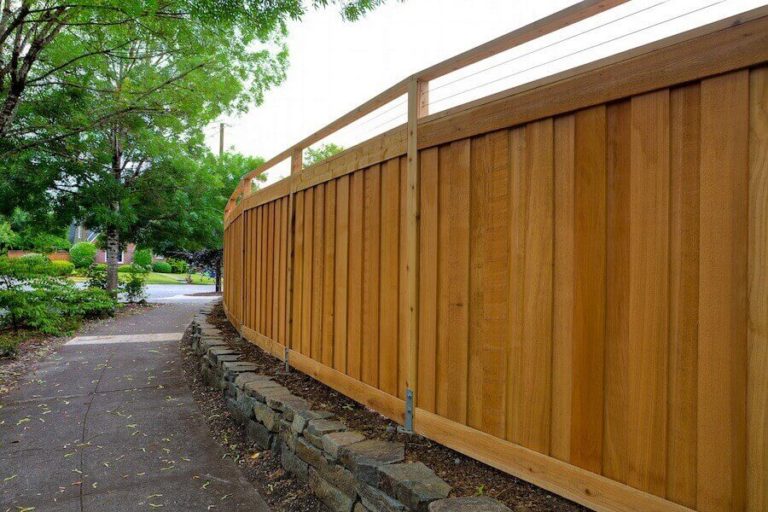All About Acoustic Fencing – 9 Questions Answered
Have you ever seen one of those large noise barriers at construction sites? Yes, you might have walked past one and thought to yourself that it’s still pretty noisy, but in actual fact, they can reduce the noise levels by half or more. Imagine not having one! Even more unwanted sound then!
And that’s where this concept can be brought to your home, where you make use of acoustic fencing to block out noise from outside. This is especially useful if you have an inconsiderate neighbor who produces lots of backyard noise, but more often than not, it is the noise from a nearby highway or a busy road that keeps you up at night.
Within your home, there are several things your can do such as using noise blocking window film or using soundproof wallpaper, but for today, we shall look at using an acoustic fence to reduce noise starting from your backyard!
We shall discuss some common questions about it and I have also included some simple steps on how you can create your own DIY sound blocking fence.
Let’s jump right in!
I am an Affiliate for Amazon and others, which means I may make a commission if you purchase something through the links here. There is NO extra cost to you at all, and THANK YOU so much for the support. Learn more here.
Contents: Skip to section
What is Acoustic Fencing and does it work?

I love the location of my home.
It’s near my kid’s school and has a backyard for them to play.
The neighbors seem decent too.
There’s only one problem.
The backyard faces a busy road that I can hear inside even when the windows are closed.
The road has gotten busier over the years and the road noise louder.
So finally I started looking into my options. Luckily I found out that you can build acoustic fences to help cut down on noise.
Acoustic barrier fences are designed to block out unwanted noise sources.
Often they are constructed by cities and townships along highways to protect a residential area from the noise of traffic.
However, you can build these yourselves.
They are similar to traditional fences commonly found around homes with a few modifications to block out the sounds of neighbors and traffic and they do cut down on noise if you construct them properly.
Hey, quick one. If you intend to start a soundproofing project soon, check out our Best Materials for Soundproofing post to get a headstart. Most projects require similar materials, so this post will save you a ton of time researching.
How effective are soundproof fences?
There are two primary types of noise:
- Airborne: This is any noise that travels through the air. Acoustic fencing can help take care of it. Obviously planes flying overhead do not count.
- Impact noise: This is caused by anything impacting your sound wall. The fence will be less effective against these.
Unless you are right up against a major highway, most traffic that you can hear in your backyard or your house ranges from 60 to 70 decibels.
That is the level of a noisy dishwasher or conversation taking place right next to you. A tall acoustic fence that is well-built will likely cut down outer sounds by 5 to 10 decibels, a significant reduction in sound intensity.
That does not sound like much, but because of the way humans perceive sound, 10 decibels will seem like a major drop.
10 decibels is the difference between a classroom full of conversations and a single conversation a few feet away – it sounds like a major difference. In fact, a 10 decibel reduction is equivalent to reducing noise by half.
While the primary example used above focuses on nearby traffic, the sound fence has multiple uses. Noisy neighbors, construction, lawn mowers and most anything else will be pared back by the presence of the fence.
Soundproofing fences will act as noise control in any of the following scenarios:
- Road noise, highway noise and traffic noise from nearby roads
- Nearby air conditioning units and pool pumps
- Neighbors’ children or nearby music
- Maintenance equipment like mowers, chain saws, general hammering and construction noise
- Environmental noise such as winds
How do acoustic fences work?
So, how do acoustic fencing work?
Basically, acoustic fences do two things to sound coming at it.
While it will not totally block out sound, it will disperse and absorb some of it. This is known as reflection and absorption.
Here is how it works:
First, the naturally rough design of bricks or wood will help scatter and diffuse sound when it hits the wall.
If you think about ceiling panels you often see in offices or schools, you will remember they are rough and textured. This is to help absorb and disperse sound and will work for fence panels too.
Second, the solid nature of the wall will help absorb sound coming through. This is why it is particularly important not to have gaps or openings between your brick or fence wood.
So the moral of the story is that you don’t want a soundproof wall that is perfectly smooth on the outside and you want it thick and free of gaps and openings.
Read more: DIY Sound Panels: How to make your own
What materials make a good soundproof fence?
You can build a homemade fence out of traditional materials including mortar, brick, or wood.
Brick and mortar will obviously have a stronger effect than wood, but is more expensive, more time consuming, and more permanent.
If you are going to use wood, you will want thick, heavy wood, and you will likely want additional insulation (which we will discuss below).
Are metallic fences good for soundproofing?
Metallic fences are a slightly different story.
Metallic fences will help to reduce any sound waves that are airborne.
These would be loud conversations, music, or distant traffic.
However anything that might cause noise vibration within your house will likely be amplified by the metal fence, because it too will vibrate. (echo effect)
Think about heavy trucks riding by rattling your dishes, or someone’s heavy loud music causing your windows to vibrate.
Therefore metal fences may not be the best noise insulators unless you’re just trying to keep out much lighter sounds.
What is the best wood for an acoustic fence?
Any traditional fencing wood will work.
However cedar and redwood are best for soundproofing. Of all the woods typically used in fences, these are the densest.
Therefore they will absorb and block the most sound.
You do not need to overthink this, as any sturdy wood will work.
Properties of sound barrier walls: Factors to consider
If you want your soundproof fence to work well, you need to pay close attention to a few key factors:
- Usage of thick and dense wood
- Typically nailed to thick and heavy rails
- Aim for the highest fence you can go
The common theme here is to ensure there is significant mass on the fence. As a general rule, increasing mass will serve to dampen noise and they are the best kind of sound barriers.
How do you build a soundproof fence?
You will need to build a wooden fence made of heavy wood.
Check with local regulations and build as high as they will let you, or as high as you’re comfortable with.
Try not to build it any further from your house than 20 feet – the further away it is, the less effective it will be.
Be sure to design your fence so there are no gaps between boards. Every gap lets in sound.
Build your fence with these steps:
- Measure the distances you want to cover around your yard.
- Purchase lumber (cedar or redwood or any other recommended wood materials).
- Put down the corner posts first (be sure to dig a deep enough hole and fill in with concrete to make your fence strong enough to bear its own weight).
- Build out from the corner posts.
- Ensure there are no gaps between wood posts.
How do you make your fence soundproof?
Once you have finished the fence, you can add the real soundproofing layer to it: mass-loaded vinyl.
MLV is basically magic. It’s made of a vinyl material (which gives it an almost wallpaper or tarp feeling to it) and the “mass-loaded” ingredient, usually barium sulfate or calcium carbonate.
This makes it heavy and dense, which is what actually makes it soundproof and perfect for sound absorption.
- Measure the interior walls of your fence
- Order MLV and materials (below)
- Cut the MLV to fit the parameters of the fence
- Nail the MLV to the fence.
- Ensure the MLV is tight up against the fence.
- Seal the edges and overlap of the MLV with caulking
That’s it! Enjoy the sounds of quiet.
*Note: MLV can be quite expensive, but they are indeed one of the best soundproofing material to use and is trusted by most professionals. Depending on your weather conditions where you live, you can consider using styrofoam and gypsum boards too (for dry weather).
Materials to build your own soundproof fence
Retractable Razor Knife
These safe razors are strong and will help you cut the MLV against the measurements you took from your fence parameters. This pack includes three retractable razors.
Ironclad General Utility Work Gloves
These will help you get a better grip on the MLV and protect you while cutting and hanging it.
Green Glue Acoustic Adhesive
This caulking can be used to seal the gaps and overlaps of the MLV. This particular caulk itself is designed to help with soundproofing.
You can use other adhesives or caulk, but this one is specifically designed to help with soundproofing.
Check out alternatives to Green Glue too.
Nail Assortment
You will be nailing the MLV to the fence itself (and then sealing the edges for good measure). This assortment of nails will ensure you have all that you need.
If you’re going to be using blankets instead of MLV, you can get hooks to hang using the blankets’ grommets.
Mass-Loaded Vinyl
This Second Skin MLV is high quality and is a top choice for MLVs. It will definitely help cut back on noise and is a must-have acoustic fencing products.
Take note though, this is heavy.
You should plan on getting someone to help hang this. Trying to handle and attach it yourself might be a challenge.
If you do not want to use MLV to build your sound wall, your alternative would be heavy blankets.
While you can use almost any heavy blanket, some will make much more of a difference.
I would recommend using moving blankets as they are a good sound absorbing material.
However, these are hard to attach.
If you nail them, then rain and elements will wear them out and lead to mildew and mold. Your best option is something with grommets built directly into it.
You can then hang those from the fence, but as I said, the effect won’t be as effective as using mass loaded vinyls (MLV).
Audimute Sound Blankets
These blankets are specifically designed to help block sound.
They are designed with grommet holes for ease of hanging
A few more noise reduction tricks
While we usually focus on reducing noise disturbances by soundproofing, you may wish to consider “fighting noise with noise”.
The main point of doing this is not to block out the noise, but rather to mask it out with sounds that are more pleasant. Obviously you can’t place a white noise machine in your backyard, but you may wish to consider installing a water feature, like a water fountain.
The splashing and gurgling noise can work to drown out the undesirable noise from outside your home.
On top of constructing the acoustic fence, try to surround it with plants and bushes. These have the added effect of absorbing sounds too, plus they beautify your garden!
And lastly, you may wish to seek out professional options, such as modular fencing or investing in an acoustic fence wrap for much needed sound protection. Some of this methods make use of special groove boards that can be more effective in soundproofing.
Are you ready to build or invest in your own noise reduction fence?
Read more:







